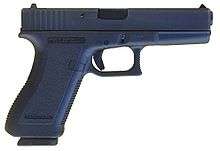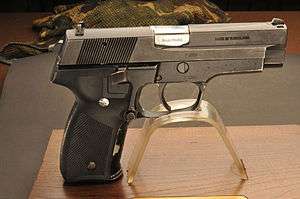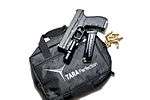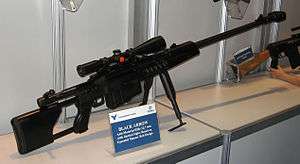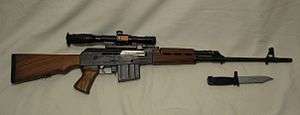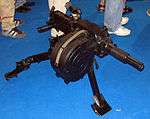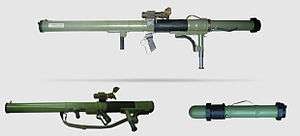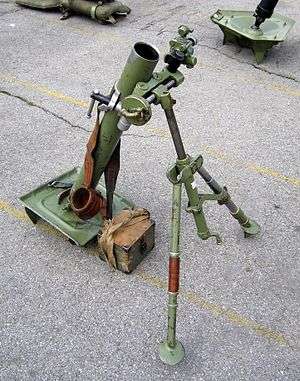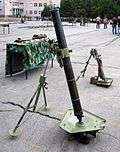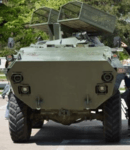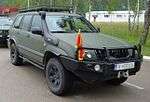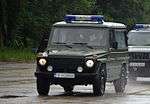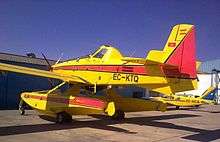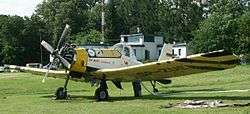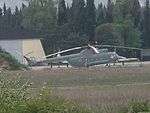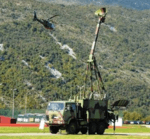Military of Montenegro
| Military of Montenegro Montenegrin: Vojska Crne Gore | |
|---|---|
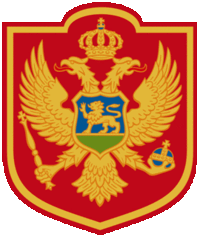 | |
| Founded | 1879 (reconstituted 2006) |
| Service branches |
Montenegrin Ground Army Montenegrin Navy Montenegrin Air Force |
| Headquarters | Podgorica |
| Leadership | |
| President | Filip Vujanović |
| Minister of Defence | Milica Pejanović-Đurišić |
| Chief of Staff | Admiral Dragan Samardžić |
| Manpower | |
| Military age | 18+ |
| Conscription | Abolished in 2006 |
| Active personnel | 1,950 (2015) |
| Reserve personnel | 400 |
| Expenditures | |
| Budget | 42 million Euro (2016) |
| Percent of GDP | 1,3% (2016) |
| Industry | |
| Domestic suppliers | TARA group |
| Foreign suppliers |
|
| Related articles | |
| History |
Battle of Krusi (1796) Battle of Lopate (1796) Siege of Cattaro (1813) Battle of Grahovac (1858) Battle of Kolašin (1858) Battle of Vučji Do (1876) Battle of Fundina (1876) First Balkan War (1912-1913) Siege of Shkoder ( 1913) Second Balkan War (1913–1913) First World War (1914-1918) Christmas Uprising (1919) |
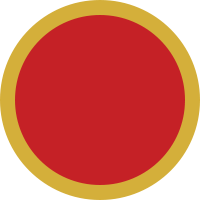
The Military of Montenegro (Montenegrin: Vojska Crne Gore) consists of an army, navy and air force. There has been no conscription in Montenegro; the military is a fully professional standing army.
The military currently maintains a force of 1,950 active duty members. The bulk of its equipment and forces were inherited from the armed forces of the State Union of Serbia and Montenegro; as Montenegro contained the entire coastline of the former union, it retained practically the entire naval force.
Montenegro is a member of NATO's Partnership for Peace program and is an official candidate for full membership in the alliance. Montenegro applied for a Membership Action Plan on 5 November 2008, which was granted in December 2009. In 2015, it was reported that international support for Montenegro's NATO membership was growing.
In December 2015, North Atlantic Council, invited Montenegro to join NATO as 29th member.[1]
Peacekeeping operations
Montenegro participates in peace operations under the NATO and UN auspices as military troops and observers. Minister of Defense said that 85 soldiers are trained for international missions.[2] Montenegrin soldiers are trained by the German Bundeswehr.[3]
Montenegro sent 45 troops and medical personnel to the ISAF mission in Afghanistan, and continues contributing in new Resolute Support Mission mission.[4] [5]
Montenegro also participates in UN peacekeeping missions in Liberia, UNMIL, Cyprus, UNFICYP as military observers and Somalia, EU-NAVFOR.
| Current Mission | Organization | Country | Nr. of personnel |
|---|---|---|---|
| RS | NATO | Afghanistan | 25 Members (Military troops and medical team) |
| UNMIL | United Nations | Liberia | Officers as military observers |
| UNFICYP | United Nations | Cyprus | Officers as military observers |
| EU-NAVFOR | EU | Somalia | Navy officers (3) |
Command
Leadership
- Commander in Chief: President Filip Vujanović
Ministry of Defense
- Minister of Defense: Milica Pejanović-Đurišić
- Chief of the General Staff: Admiral Dragan Samardžić
Bases
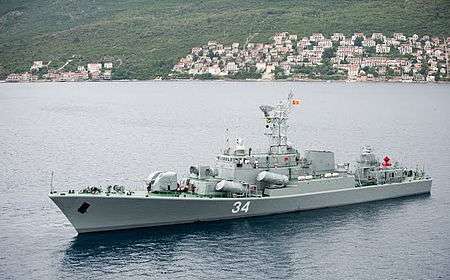
Air Bases
Naval Bases
Bar Naval base, (Bar)
"Pero Ćetković" base, (Bar)
Pristan base, (Herceg Novi)
Army Bases
Army base "Milovan Šaranović", (Danilovgrad)
Army base "13 jul", Nikšić, (Nikšić)
Army base "V. K. Volođa", (Pljevlja)
Army base "Breza", (Kolašin)
Units & Structure


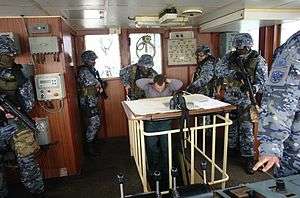
 General Staff - Podgorica[6]
General Staff - Podgorica[6] Infantry Battalion
Infantry Battalion
- 1st Infantry Company
- 2nd Infantry Company
- Mountain Company
- Fire Support Company
- Engineer Company
- Signal Platoon
- NBC Defence Platoon
- Service Squad
-
 Navy
Navy
- Patrol Boat 33
- Patrol Boat 34
- Training Ship "Jadran"
- Auxiliary Boats Squad
- Marine Platoon
- Coastal Surveillance Company
- Support Company
 Air Force
Air Force
- Flying Squadron
- Support Company
- Air-Defense Company
- Air Base Security Platoon
-
 Logistic Battalion
Logistic Battalion
- Logistic Maintenance Company
- Logistic Mixed Company
- Logistic Warehouse Company
- Medical Platoon
 Training Center
Training Center
- First Subcenter
- Second Subcenter
- Teaching Resources Service
- Shooting Range
- Service Squad
 Honorary Guard Company
Honorary Guard Company Intelligence-Reconnaissance Company
Intelligence-Reconnaissance Company Military Police Company
Military Police Company Signal Company
Signal Company
Ranks and insignia
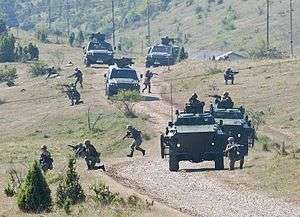
Enlisted rank insignia
| NATO Code | OR-1 | OR-2 | OR-3 | OR-4 | OR-5 | OR-6 | OR-7 | OR-8 | OR-9 |
|---|---|---|---|---|---|---|---|---|---|
| Insignia |  |
 |
 |
 |
 |
 |
 |
 |
 |
| Title | Razvodnik | Desetar | Mladji Vodnik | Vodnik | Vodnik Prve Klase | Stariji Vodnik | Stariji Vodnik Prve Klase | Zastavnik | Zastavnik Prve Klase |
Ground Army and Aifrorce Officer rank insignia
| NATO Code | OF-1 | OF-2 | OF-3 | OF-4 | OF-5 | OF-6 | OF-7 | OF-8 | OF-9 | |
|---|---|---|---|---|---|---|---|---|---|---|
| Insignia |  |
 |
 |
 |
 |
 |
 |
 |
 |
 |
| Title | Potporučnik | Poručnik | Kapetan | Major | Potpukovnik | Pukovnik | Brigadir | General Major | General Potpukovnik | General Pukovnik |
Navy Officer rank insignia
| NATO Code | OF-1 | OF-2 | OF-3 | OF-4 | OF-5 | OF-6 | OF-7 | OF-8 | OF-9 | |
|---|---|---|---|---|---|---|---|---|---|---|
| Insignia |  |
 |
 |
 |
 |
 |
 |
 |
 |
 |
| Title | Poručnik Korvete | Poručnik Fregate | Poručnik Bojnog Broda | Kapetan Korvete | Kapetan Fregate | Kapetan Bojnog Broda | Komodor | Kontra Admiral | Vice Admiral | Admiral |
The Military before 1918
After military successes in the wars 1876-1878 during which the Principality of Montenegro was enlarged by a large territory, from the Tara River in the north to the Adriatic Sea in the south (liberated towns Podgorica, Nikšić, Kolašin, Andrijevica, Bar and Ulcinj), reorganization in Montenegrin army was conducted in 1880. Each kapetanija (municipality) formed its reserve battalion. There were 42 battalions in total. Since 1881, regular military exercises were conducted.
Supreme Commander of the Montenegrin army was the monarch, Prince / King Nikola I. Operational command, organization and financial support of the Montenegrin army was entrusted to the Ministry of Defence, the department of the Government of the Principality / Kingdom of Montenegro.

General Staff of the Montenegrin army was part of the Ministry of Defence.
In 1882 first 14 Montenegrins were sent to officer schools abroad, particularly in Italy and Russia. In 1886, 10 of them completed their education and they become first trained officers in Montenegrin warrior history. These Montenegrin officers held courses in Podgorica, Nikšić and Cetinje.
In September 1895, the first permanent Infantry NCO school in Podgorica was opened, and the first NCOs got desečar rank. At the end of 1896, artillery officer school in Cetinje was established - the first Montenegrin officer school.
Formations and ranks
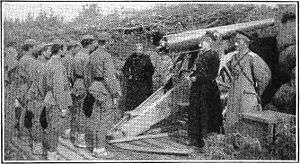
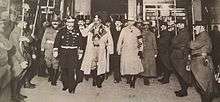
In 1906 Montenegrin army received the first systematized regulations, and the Law on Organization of the Army was adopted in 1910. Infantry and artillery, were established, followed by two specialized branches (reconnaissance and pioneering), and additional branches (medics, military workshop, the military court staff, gendarmerie and logistics).
In 1913 the Montenegrin gendarmerie become a special Military Police unit.
Since the establishment of the internal Montenegrin telecommunications system in 1869, vital for the flow of military-defense information, it was under the jurisdiction of Ministry of the military.
Until 1912, the territory of the Kingdom of Montenegro was divided into four divisional areas:
- 1.Cetinje divisional area
- 2.Podgorica divisional area
- 3.Nikšić divisional area
- 4.Kolašin divisional area
After wars 1912th-1913th established additional two divisions field:
By 1912, the Montenegrin Army had 11 brigade areas, 52 districts and 322 battalion troop areas. Divisions were composed of 2-3 Infantry Brigade.
Each divisional command had three artillery batteries. On the eve of the First Balkan War Kingdom of Montenegro lined up 55,000 soldiers.
All Montenegrins between 18 and 62 years were conscripts. Recruitment was done three times a year, and the recruits are in peacetime had to have at least 25 years.
- Officer ranks were: potporučnik, poručnik, kapetan, komandir, brigadir, divizijar
- NCO ranks were: desečar, donarednik, narednik
- Ceremonial ranks were: serdar, vojvoda
After the establishment of the Kingdom of Montenegro in 1910, Montenegro was involved in three wars with the first one being the First Balkan War, in alliance with Serbia, Greece, Romania, and Bulgaria against the Ottoman Empire. The Second Balkan War was fought between Montenegro, Serbia, Greece, Romania and the Ottoman Empire against Bulgaria, with Bulgaria consequently losing significant territory in the north, Thrace, and Macedonia.
The Military of Montenegro before 1918, was much larger than today's military. During World War I, Montenegro mobilised 50,000 troops. The Commander-in-Chief was King Nikola I of Montenegro, while the General of Staff was Božidar Janković. Units included:
- Pljevlja Division
The Pljevlja Division was commanded by brigadier Luka Gojnić. The division was made up of 10 battalions. It had around 6,000 soldiers, and patrolled the area east from Pljevlja.
- Herzegovina Detachment
The Herzegovina Detachment was commanded by Serdar (Count) Janko Vukotić. The detachment was made up of 15 battalions. It had around 15,000 soldiers, and patrolled the border with Herzegovina.
- Lovćen Detachment
The Lovćen Detachment was commanded by divizijar Mitar Martinović. The detachment was made up of 18 battalions. It had around 8,000 soldiers, and patrolled the areas of Lovćen and Sutorman.
- Old Serbia' Detachment
The 'Old Serbia' Detachment was commanded by brigadier Radomir Vešović. The detachment was made up of 13 battalions. It had around 6,000 soldiers, and secured the Albanian border.
Equipment
Ground Army
Navy
| Class | Number | Contury Manufactured | Notes | Pictures | |||
|---|---|---|---|---|---|---|---|
| Frigate | |||||||
| Kotor class frigate | 2 in active service | |
- P-33 Kotor - P-34 Novi Sad |
 | |||
| Fast attack craft | |||||||
| Končar class fast attack craft | 2 overhauled and in storage | |
- RTOP-405 Jordan Nikolov Orce - RTOP-406 Ante Banina |
 | |||
| Transport and support | |||||||
| PO class | 1 in reserve | |
- PO91 | ||||
| Tugboats | |||||||
| Salvage tug | 2 in active service | |
- PR-41 (Orada) - LR-77 |
 | |||
| Sailing ship | |||||||
| Jadran | 1 in active service | |
Used as a training ship | | |||
| Motor sailboat | 2 in active service | |
- Bojana - Milena |
 | |||
| Motorboat | |||||||
| Diving boat | 2 in active service | |
-Ronilačka baraksa 81 -Ronilačka barkasa 85 |
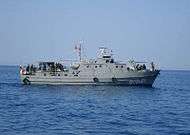 | |||
| Motor boat Polycat | 1 in active service | |
|||||
| Motor boat | 1 in active service | |
- ČM 33 | ||||
| Inflatable boat | |||||||
| Valiant 620PT | 2 in active service | |
Used by Marine Platoon |  | |||
| Motor Yacht | |||||||
| Jadranka | 1 in active service | |
VIP Yacht |  | |||
| Floating Crane | |||||||
| Floating Crane | 1 in active service | |
LDI 18 | 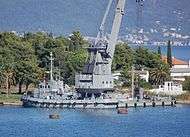 | |||
Airforce
Gallery
 Special forces
Special forces- Montenegrin troops in Afghanistan
.jpg) Montenegrin troops in Afghanistan
Montenegrin troops in Afghanistan Infantry Company
Infantry Company Infantry Company
Infantry Company Sniper
Sniper Achleitner RCV Survivor
Achleitner RCV Survivor BOV M86
BOV M86 Combat drill
Combat drill Soldier
Soldier- NBC Defence
 Military Police
Military Police Montenegrin navy boat
Montenegrin navy boat- Montenegrin soldier holding a HK MP5
See also
References
- ↑ http://www.nato.int/cps/en/natohq/news_125370.htm
- ↑ Spremaju se za Avganistan
- ↑ David Noack: Subsidiary Troops (German: Hilfstruppen), german-foreign-policy.com, 17.03.2008.
- ↑ Kasarna Danilovgrad: Svečanost za vojnike koji idu u Avganistan.
- ↑
- ↑ http://www.rtcg.me/vijesti/arsenal/68533/do-efikasnije-i-operativnije-vojske.html
- ↑ http://www.gov.me/files/1256832119.pdf Page 15
- ↑ Montenegro army land ground armed forces military equipment armored vehicle intelligence pictures - Army Recognition
External links
| Wikimedia Commons has media related to Military of Montenegro. |
- Official Website (Montenegrin)
- Montenegro in NATO (Montenegrin)
- "Europe’s Newest State Trims the Army" (DefenseNews.com)
- "Appointment of the Acting Chief of the General Staff of the Army of Montenegro" (Website of the President of Montenegro)
- Montenegrin Armed Forces / Vojska Crne Gore - VCG
- Perspective of the Military of Montenegro, in English
- Montenegrin Armed Forces before 1918 / Vojska Crne Gore prije 1918
- Debate on NATO in Montenegro
- Milo Đukanović appoints himself as Minister of Defense
- / Forum article about Montenegrin military (Serbian)
